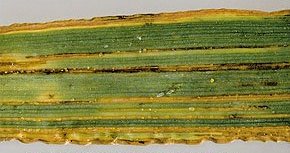Bacterial Blight On Wheat, Oats And Barley
Bacterial blight infestations only occur after prolonged periods of wet weather. They are usually localized within the field and therefore do not usually cause widespread damage.
Host Crops
Wheat, oats, barley
Biology
This disease is caused by a common bacterium that persists in soil and water and is spread by wind-driven rains. The bacteria overwinters on crop residue, seed, fall-sown cereals and perennial grasses. Spring infection may result from any of these sources. Subsequent infections are spread by splashing rain drops, plant to plant contact and insects.

Bacterial blight develops on the upper leaves of wheat during periods of cool, wet weather, after the plants have reached the boot stage. Leaf blight is associated with high relative humidity, wet weather, and cool spring temperatures (15ºC to 25ºC). Warm, dry weather stops the disease and new emerging leaves may be relatively free of bacterial infection.
Symptoms Of Damage
The initial lesions appear as small water-soaked spots. The lesions expand and then appear as dry dead tissue. The spots often join within a few days to form large blotches. The entire surface area of an infected leaf may be affected. During wet periods, bacterial ooze may develop within the lesions. The head does not usually develop symptoms.
Scouting Techniques
Look for lesions that progress from grey-green to tan-white and join to form irregular streaks or blotches.
Control Tips
- Avoid infesting clean fields by following good production practices. Use seed from crops that are free of bacterial disease. Use a crop rotation of three or four years.
- Mow infected wild grass along headlands before sowing winter rye. No chemical controls exist.

